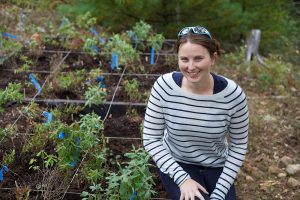Uncovering the Past Through Maine’s Historic Phenology Data
Dr. Caitlin McDonough is a David A. Smith Conservation Biology Fellow at the University of Maine. Her research focuses on the historical and current plant and bird phenology of the Acadia and Oxbow regions of Maine.

Long-term, historical phenology records have been among the first datasets used to identify the fingerprint of anthropogenic climate change in ecological communities. Phenological observations of annual first flowers, first leaves, and first migratory bird arrivals are a very valuable component of climate change research and historical phenology records provide baselines for learning about the effects of climate change on biota and biological processes. For example, renowned natural historians Henry David Thoreau and Aldo Leopold created detailed scientific catalogs of plant flowering dates and other phenology observations, while fishermen, farmers, foresters, and amateur naturalists have routinely kept phenology logs for centuries. These records have the potential to temporally and spatially expand ecological studies, though unlike Thoreau and Leopold’s work, most have not been analyzed or preserved in publicly accessible museums or historical collections.
A phenology journal for the Oxbow region in Aroostook county (about 60 km southwest of Presque Isle), created by a mid-20th century a hunting guide named L.S. Quackenbush, was recently re-discovered, revealing a valuable set of records that have been integral to Dr. Caitlin McDonough’s research, allowing her to compare the northern Maine region with historical and current records for the coastal Acadia region. A rich and detailed log of the seasons, Quackenbush recorded daily natural history observations and later indexed his own entries into lists of first flowering, leaf out, and migratory arrival dates.
Interestingly, the Quackenbush journals found their way into scientific study serendipitously. They were first donated to Acadia National Park after Quackenbush died in the 1960s. But at the time phenology was not a dynamic and active research area and as a result the journals were stored in an attic at College of the Atlantic. Fortuitously, the journals resurfaced during an age of enthusiasm for phenological research and digitizing historical records. Researchers quickly recognized their potential, scanned the journals, and set about comparing phenological observations to historical temperature records.
Quackenbush’s routine observations, recorded daily in a rural outpost in the most northern Maine count, are now considered an important contribution to climate change research. Up until this point this northern Maine region had been minimally studied due to its remote location, low population density, and relative lack of historical data or active ecological research sites. For example, a couple of recent studies on Maine spring phenology have excluded this region: 1) a study of migratory bird arrival dates explicitly excludes Aroostook County, and 2) a regional study using pheno-cams to monitor leaf out dates only extends as far north as Howland Forest in central Maine. Though comparisons of Quckenbush’s bird observations to contemporary bird observations are less straightforward, the Quackenbush information fills an important gap in regional migratory bird phenology studies.
Since the rediscovery of the Quackenbush journals, McDonough and her colleagues have traveled to Oxbow to see Quackenbush’s study area, and are in the process of launching collaborations with local scientists interested in building on his data. Scientists at University of Maine Presque Isle have begun systematically collecting phenology research around campus and in Oxbow, a project inspired by Quackenbush’s journals that will allow researchers to compare changes in phenology from the 1940s and 1950s to the 21st century. So far, researchers have found Quackenbush’s leaf out and flowering phenology observations are closely tied to spring temperatures and match the direction, though not the magnitude, of changes found in Southern New England plant communities as a result of climate change. The Quackenbush journals, and many other, yet-undiscovered records, provide a unique opportunity to study the ecological effects of climate change and climatic variation in the Northeast.
By Dr. Caitlin McDonough. Edited by Sara Randall.
